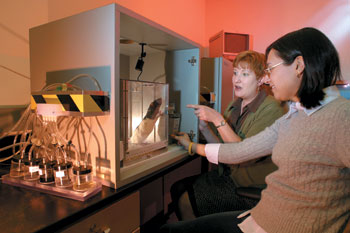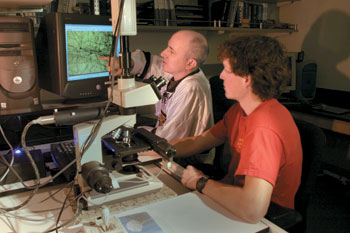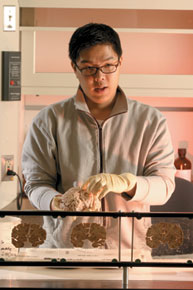




| Neuroscience: Explaining Why We Do What We Do | |
| By Anne Christensen Photos by Tom Kimmell |
 |
| Professor Lori Driscoll ’94 and Caitlin Dufault ’05 cheer for Rat A41, who’s been retired from lab work for six months but still remembers how to respond correctly to sequences of light flashes and odors to earn sweet food pellets. |
Charlie Hass ’05 considers the firm, dusky-pink human brain he’s cradling familiarly in his outspread hand. “We assume that because we have these gargantuan noggins, we’re set aside from other animals, but we’re pretty similar,” he says. “Ultimately, our problem-solving strategies are similar to nonhuman primates. It’s neat to see evolution funnel energy into a basic solution.”
Leave it to a student like Hass to keep the big picture in mind, even while he conducts research on spidery neurons each less than a millimeter long in any dimension. To conduct research at that level of detail, Hass works for hours hunched over the Neurolucida™ system — a computer interfaced with a microscope that displays the branches of neurons in three dimensions — painstakingly tracing their dendritic branching. (See photo, next page.)
Neuroscience Professor Bob Jacobs has involved about 30 students in research like this during the nine years that CC has offered an interdisciplinary neuroscience major.
| “ | I thought I would major in American history, but the question I wanted to answer — why humans act the way they do — couldn’t be answered by history and anthropology after a point. I wanted a more biological perspective, and neuroscience offers that.” |
| – Charlie Hass ’05 |
The goal of Jacobs’ research is to establish a baseline for regional differences in various areas of the cortex, the outer layer of the human cerebrum (the “thinking” part of the brain). Each student who collaborates in the research develops tracings for a specific area of several normal cortices; Jacobs, as a sort of meta-researcher, looks at results across cortical areas — tracing close to 2,000 neurons to date (the only lab anywhere to conduct this kind of basic research in the human brain).
“Collaboration has worked well for me,” says Jacobs. “I can give students fairly circumscribed research areas, then compile them for publication. One advantage of not being an R1 institution is that we can hold back and collect enough data for several years to make one large data set, from which we can draw conclusions. Students’ work goes into major journals, and we present our results in poster format at national conferences, where there are 20,000 to 30,000 people in the neuroscience field. It’s an eye-opening experience for our students.”
 |
| Professor Bob Jacobs and Charlie Hass ’05 use a state-of-the-art Neurolucida™ system to examine branching in a human cortical dendrite |
Paraprofessional Hyo Won Lee ’04 says he developed strong technique by working with Jacobs. “Bob is so meticulous about getting data — his criteria are so strict, his data are so good, that other researchers really use them,” Lee says. Publishing with Jacobs improves students’ chances of getting highly sought-after internships as well as graduate and medical school slots. CC’s neuroscience majors (15 in the class of 2006) compete favorably with “the best of the best” from all institutions, says Jacobs; two are now at the University of California-San Diego, the top neuroscience graduate program in the country.
Simply having Neurolucida™ experience helps CC alumni get into grad school and professional research, says Katie Travis ’03, who just published an article in Developmental Neuroscience, an international journal. For her, it provided entrée into a neuroelectrophysiology lab at the National Institutes of Health (NIH), where she works with postdocs researching normal nerve firing in the hippocampus, the area responsible for learning and memory — research which may eventually be used to help understand epilepsy and other nerve-firing disorders. (Because of their morphology experience, Jacobs says, perhaps four or five CC alumni work at NIH at any time.)
Travis is now headed for grad school, where she hopes to return to an area related to her CC thesis: how children acquire second languages. “What’s the cortical representation of that second language? What areas of the brain are they using as they acquire it — the same as for the first language?” she asks, wondering how the children’s ages might affect which areas of the brain are used. “We know that Scandinavian children start to acquire English much earlier than middle school, and they speak much better than American children who start later to acquire a second language.”
| “ | One of the things I’m proudest of is building a neuroscience community. My students are part of an extended family. We have neuroscience dinners with alumni in Ph.D. programs; they give advice to students and younger alumni.” |
| – Neuroscience Professor Bob Jacobs |
The language-acquisition subspecialty snagged Travis’s attention as she worked with Jacobs at CC, comparing dendritic complexity in the brains of people of different ages and with different levels of education. Infants’ brains vary widely in development according to stimulation; less complex regions like those controlling vision develop quickly, while the region responsible for mathematical reasoning grows more slowly but develops more complexity. Similarly, Jacobs has found that highly educated people who continue intellectual work throughout their lives have longer and more complex dendritic branches.
While Jacobs’s work focuses on cellular aspects of neuroscience, Professor Lori Driscoll ’94 explores how changes in the brain affect behavior. Her specialty is investigating how everyday toxins influence brain development and cognition, and her current research focuses on polybrominated di-phenyl ethers (PDBEs), flame retardants banned in Europe but used widely in foam cushions and upholstery in the U.S.
Chemically similar to thyroid hormone, PDBE appears to have similar effects in the infant brain — that is, infants exposed to the chemical appear to be more likely to develop attention problems later, just as young children whose bodies fail to produce enough thyroid hormone are more likely to have attention deficit disorder (ADD) later.
| “ | Psychology studies behavior; neuroscience studies what underlies behavior at the cellular level. You don’t have to believe that behaviors are a result of cellular processes. You don’t even have to believe that the heart pumps blood through the body, but the evidence points in that direction.” |
| – Katie Travis ’03 |
Driscoll and Caitlin Dufault ’05 (daughter of Momi Ching Dufault ’72) conducted research on attention last summer, using rats as subjects. (Dufault’s participation was funded by a grant from the Howard Hughes Foundation.) “The exposed animals have trouble learning tasks,” says Driscoll. “We suspect impairment of their cholinergic systems — the neurons that produce the neurotransmitter acetylcholine, which is how neurons signal each other. Those neurons communicate with the cerebral cortex, which is activated when we pay attention. Less acetylcholine means less ability to pay attention.”
However, once the impaired rats learned the tasks, they were able to pay attention to performing them, says Driscoll. Further research indicated that the rats may have developed coping strategies that don’t depend on the cholinergic system. Dufault, one of many who came to CC specifically for the neuroscience major, will be first author on the published article. She says, “I was used to DNA replication techniques and other forms of lab research, but this type of research was new to me. It’s hard to read the rats’ minds if they’re not doing their tasks: Are they frustrated? Unmotivated? Just not hungry? Lori has been very supportive of my growth process in research.”
Dufault says she hopes to intern at NIH next year, then apply to medical school: “I need to know the backbone of medicine, how to detect illnesses before they manifest themselves, how drugs are developed, as well as how to work with people as a clinical doctor. I really like helping people.”
 |
| Paraprofessional Hyo Won Lee ’04 uses a human brain to demonstrate how the sulci (folds) vary from person to person, depending on gender, genetics, and development. |
| “ | I’d like to mathematically model the integration of visual perception and the motor system. Eventually I’d like to go into neuroengineering, using microelectromechanical systems in the brain to obtain signals for specific movements, then using those signals to direct the movement of robotic prosthetic limbs.” |
| – Hyo Won Lee ’04 |
The Colorado College | 14 East Cache La Poudre Street | Colo Sprgs, CO | 80903 || 719-389-6000